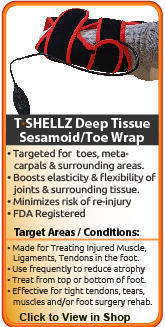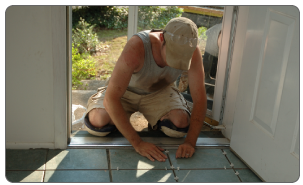More Facts About Achilles Tendonitis:
The Achilles tendon does not have a rich blood supply. Blood supply is weakest at a point between 2 and 6 cm above its insertion into the calcaneus (heel bone).
Ignoring pain in the Achilles tendon (ie. "running through the pain") is the biggest cause of chronic Achilles tendonitis.
For cyclists, initial Achilles tendon stress is often caused by having a low saddle height. This low saddle height can result in excessive dorsiflexion of the foot, which stresses the Achilles tendon.
The Achilles tendon is the connection between the heel and the most powerful muscle group in the body.
Tennis and soccer players over 40 are the most frequent sufferers of tennis leg (calf muscle strain).
Sudden increases in running and or active sprinting sports can cause Achilles tendonitis.
Excessive running up and down hills can aggravate the Achilles tendon.
Stiff shoe soles at the ball of the foot will increase Achilles tendon strain.
Excessive heel shock absorption can overstretch the Achilles tendon.
Tight hamstrings and/or tight calf muscles create excess strain on the Achilles tendon.
For triatheletes, the most common cause of injuries to the Achilles tendon is overpronation, inflexibility, or lack of strength.
Immobility, due to an Achilles injury, may result in a contracted Achilles tendon and an increased amount of scar tissue.
| Injury Due To Repetitive Strain/Stress
A injury due to repetitive movement is an injury or multiple injuries to the nervous system and musculoskeletal structure caused by repetitive use of one or more muscles and joints in the body. It happens when you perform the same action over and over again.
A repetitive stress injury usually occurs after the age of 30 and is a result of wear and tear from the overuse of muscles, tendons, joints and ligaments as you age. These repetitive motion injuries can occur in the shoulders, back, neck, hands, hips, wrists, elbows and lower limbs. It is a general term that refers to many conditions including (but not limited to) Carpal Tunnel Syndrome, de Quervain's Disease, Writer's Cramp, Vibration White Finger, Radial Tunnel Syndrome, bursitis, tendinitis (tendonitis), tenosynovitis, and trigger finger.
Injuries due to repetitive movement are quite common and often referred to by other names including: repetitive stress injury, repetitive motion injury, repetitive motion disorder (RMD), cumulative trauma disorder (CT), occupational overuse syndrome, overuse syndrome, regional musculoskeletal disorder, and work related upper limb disorder (WRULD, ULD).
RSI Symptoms
- Tenderness, swelling, and redness in the affected area.
- Pain when you move the area that may cause you to wake throughout the night.
- Numbness, stiffness, weakness or tingling in the affected muscles, tendons, joints and bones.
- Discomfort brought on by a particular task that improves when it is stopped - i.e., when pain lessens or disappears over weekends or during holidays.
RSI Causes
- Daily repetitive movements (usually longer than 2 hours per day) usually involved with working in a factory (sautering or assembling pieces), office (typing or clicking a mouse), or warehouse (lifting or twisting).
- Poor posture while working at a desk or awkward positioning while performing tasks such as shoveling, sliding, lifting, and twisting frequently.
- Heavy loads and forceful exertion on bursae, muscles, tendons, joints, and ligaments that cause trauma or fatigue.
- Frequent vibrations that cause blood vessels to constrict and impair circulation.
- Repeating the same movement during a sport or leisure activity such as gardening.
Examples of Repetitive Strain Injury
- Housemaid's Knee (pre-patellar bursitis) - long periods of time kneeling to tile or scrub a floor
- Biceps tendinitis (tendonitis) - repeated scrubbing motion
- De Quervain's Disease - repeated twisting of the wrist or pinching motions
- Tennis elbow (lateral epicondylitis) - forceful backward bending of the wrist when painting with a brush
- Golfer's elbow (medial epicondylitis) - forceful forward or twisting motion of the wrist when pulling on ropes
RSI Treatments
If a Repetitive Stress is detected early, there is a greater chance that the condition can be reversed and symptoms can be eased.
If you have been diagnosed with RSI, it is recommended that you rest the injured body part from any aggravating factors, especially the task(s) that caused the condition. Your physician may also recommend painkillers/anti-inflammatories, PT, the use of a Cold Compress or Ice Pack, stretches and exercise, ultrasound and/or tens. We recommend you speak with your physician about utilizing our home treatment devices for enhancing your recovery.
Learn More About Achilles Injuries & TreatmentsI want to learn more about Achilles Surgery & Post-Surgery Recovery I want to learn more about Circulation Boost I want to learn more about Ice & Heat: Which Is Better For The Achilles? I want to learn more about Stretching for the Achilles
FREE SHIPPING ON ALL PRODUCTS CURRENTLY ENABLED
60 DAY TRIAL PERIOD
During your recovery, you will probably have to modify and/or eliminate any activities that cause pain or discomfort at the location of your soft tissue injury until the pain and inflammation settle. The more diligent you are with your treatment and rehabilitation, the faster you will see successful results! Product Advisors are available 9:00 am to 5:00 pm Eastern Standard Time Monday to Friday.
|

Achilles Tendon Facts
There are over 250,000 achilles tendon injuries each year in the US.
Achilles tendon ruptures are common in people between the ages of 30 and 50.
In runners, too rapid an increase in mileage, hill training without proper strengthening, and recent or inadequate changes to running gear can cause injuries to the Achilles tendon.
Achilles tendonitis accounts for an estimated 11% of running injuries.
3-5% of athletes are forced to leave their sports career due to Achilles tendon overuse injuries that go untreated.
Medications mask the pain but do very little in the healing of Achilles tendonitis.
A fully ruptured tendon REQUIRES surgery. It will not heal on its own.
Achilles tendonitis and Achilles tendinitis are the same thing.
Continually using your Achilles tendon while it is injured will lead to a more serious and/or chronic injury.









|














